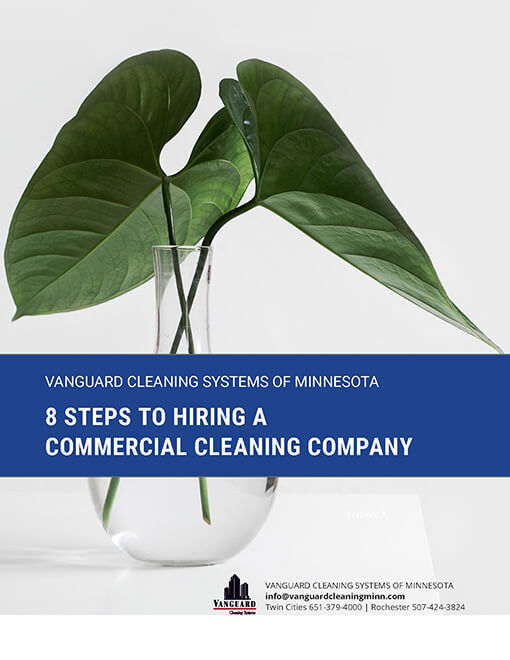Vanguard Cleaning Systems

Healthy Office Tips
Ideally, the only thing catching in creative offices spaces is the spirit of creativity.
Sadly, sometimes that is not the case.
Open offices may, instead, be hotbeds of illness.
In This Article
Colds, Flu, and Sick Building Syndrome … Oh My!
Perhaps the most readily apparent issue that can arise in open office environments is the spread of contagious disease.
Who hasn’t had a co-worker that refuses to cover a cough or simply stay at home when ill?
This is, of course, a problem in any office, but an open office floor plan simply exposes more people to the illness.
In a study of over 1,800 office workers in Sweden, those who worked in an office with an open floor plan were twice as likely to miss work for a few days because of illness than were those who worked in private offices.
For More Information:
- Office design’s impact on sick leave rates
Motherboard notes;
Another survey from Canada had similar results, with open office workers taking an average of 3.1 sick days in a year, compared to 1.8 sick days for employees who worked from home.
Open offices have also been associated with higher rates of Sick Building Syndrome.
Is Your Open Office Making You Sick?
The EPA defines Sick Building Syndrome in this way;
The term ‘sick building syndrome’ is used to describe situations in which building occupants experience acute health and comfort effects that appear to be linked to time spent in a building.
Sick Building Syndrome
Common causes of Sick Building Syndrome include:
- Inadequate ventilation
- Chemical contaminants inside the building
- Chemical contaminants from outside the building
- Biological contaminants
Sick Building Syndrome is bad news for building occupants because it can cause symptoms such as:
- Headache
- Eye, nose, and throat irritation
- Dry cough
- Dry, itchy skin
- Dizziness and nausea
- Fatigue
- Sensitivity to odors
- Difficulty in concentrating
Poor indoor air quality is a big health problem for the people who have to deal with it.
But it is a big problem for the economy too.
As far back as 1997, Fisk and Rosenfeld estimated that taking steps to improve indoor air quality could result in;
[P]otential annual savings and productivity gains of $6 billion to $19 billion from reduced respiratory disease; $1 billion to $4 billion from reduced allergies and asthma, $10 billion to $20 billion from reduced sick building syndrome symptoms, and $12 billion to $125 billion from direct improvements in worker performance that are unrelated to health.
Estimates of Improved Productivity and Health from Better Indoor Environments
Imagine how the cost of poor indoor air quality has grown in the years since 1997!
Steps to Create a Cleaner Creative Office Space
Something obviously needs to be done if you are an unfortunate occupant of a sick building or if you detect that your open office space is making you more susceptible to illness.
Here are some practical measures you can take to improve your situation:
Step One: Let in Outside Air
While it is true that outside air pollution does exist, outdoor air quality is better than indoor air quality.
If possible, open windows on pleasant days, if only for a few minutes.
As it turns out, there is nothing like a little fresh air to make breathing easier.
If it is not possible to open windows, ensure that the ventilation in your office is in good repair.
Clean vents regularly, and pump in sufficient fresh air to compensate for indoor air pollution.
Step Two: Eliminate the Source of Contaminants
In many cases, chemical contaminants that come from carpeting, upholstered furniture, and even drapery can be a significant source of air contamination.
Something as simple as replacing carpeting with hardwood or tile, replacing cloth upholstery with leather or another easy-to-clean material, and dispensing with cloth drapery in favor of wood blinds may help.
Step Three: Bring in Some Greenery
One of the reasons outdoor air quality is better than indoor air quality is that plants exist outside.
There are a variety of plants that you can use in your office to improve indoor air quality.
Plants suck up harmful carbon dioxide from the air and supply oxygen.
Thus, using plants indoors can give your air quality a natural boost.
Step Four: Go Green to Clean
Another great way to improve your indoor air quality and help prevent illness is to ditch the harsh cleaning products in favor of green cleaning products.
This is especially important if anyone in your office suffers from allergies or asthma, as harsh chemical cleaners often exacerbate these ailments.
By using green cleaning products and services, you:
- Create a more healthy office environment.
- Improve indoor air quality in a natural way.
- Help save the planet in the process.
Takeaway
Sick building syndrome, as well as other illnesses common in the winter season, can wreak havoc on a creative office environment.
While colds and the flu are typically unavoidable, businesses can, and should, do everything within their power to ensure disease is not spread through their office, workers, and customers.
Search Our Blog
Subscribe to Our Blog
TAKE ACTION
Looking for an experienced to help you and your colleagues stay healthy?
Vanguard Cleaning Systems of Minnesota can help you consider all your needs and options before you make a move. Download our free guide, “8 Steps to Hiring a Commercial Cleaning Company”

